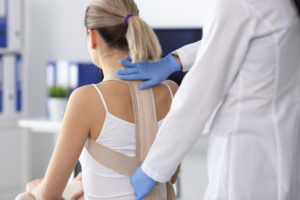 Back braces can be helpful in supporting your back, especially if you have scoliosis. Read more about the different types of braces and how these can help support your back.
Back braces can be helpful in supporting your back, especially if you have scoliosis. Read more about the different types of braces and how these can help support your back.
Has your doctor recommended a back brace for scoliosis? Learn about the different types and uses of scoliosis braces.
When you have scoliosis, support can come from a lot of directions. You may have some medical support in the form of your physician(s) or physical therapists. Mental health support to help you maintain a healthy body image can give huge quality of life improvements. And, sometimes your spine needs actual, physical support.
In some cases, that physical support might mean a back brace. Back braces can help your abnormal spinal curves for getting worse, but using a back brace for scoliosis can be fraught with unforeseen barriers. We’ll point out the pitfalls and help you decide if a back brace for scoliosis is the right treatment for you.
When Do You Need a Back Brace for Scoliosis?
Scoliosis is characterized as mild, moderate, or severe, depending on the degree of curvature using Cobb’s angle. Moderate scoliosis is often treated with a back brace.
- Mild scoliosis, a curvature between 10 and 25 degrees, does not require immediate intervention. Spine specialists observe patients in this category for progression every four to six months. If there is a one degree per month or more increase in that time interval, patients receive treatment options.
- Moderate scoliosis, defined as a curvature of 25 to 50 degrees or a rapidly progressing curve, is treated with a back brace. The goal of using a back brace for scoliosis is not to correct the spinal curve but rather to stop its progression.
- Severe scoliosis, a curvature of more than 50 degrees, is surgically managed. Patients in this category need a spinal fusion. Without surgical treatment, patients will not improve and may suffer from progressive pain, respiratory compromise, and disability.
Spine specialists diagnose most scoliosis patients in late childhood or early adolescence. Although treatment depends on the degree of curvature, for moderate scoliosis, multiple research studies, such as this 2018 meta-analysis published in American Journal of Physical Medicine & Rehabilitation, support using back braces for scoliosis in children before the adolescent growth spurt. Early brace use initiation is important because progressive scoliosis is likely to worsen if untreated during periods of rapid skeletal growth.
How Does a Back Brace for Scoliosis Work?
According to Andrés Ferrin, MD, orthopedic surgery fellow at Austral University Hospital in Buenos Aires, Argentina, a back brace for scoliosis is “a medical device that is custom fit and applies pressure to the spine with the goal of preventing progression of scoliosis.”
The amount of time that the patient wears the brace depends on the degree of curvature and the rate of progression. Patients can wear scoliosis back braces all the time or at night only.
Dr. Ferrin explains, “Many scoliosis patients want to have surgery because wearing a brace is inconvenient.”
You may have heard that the best form of exercise is the kind you’ll do consistently, and that can be true for some medical treatments. Many people have a tough time being consistent with braces for reasons such as:
- Physical discomfort
- Worsened body image and mental health
- Long-term atrophy of some back muscles
- Pain near the scoliosis curve being shifted to other areas of the spine
Despite the inconveniences of braces, spine specialists recommend bracing for moderate scoliosis.
Posterior spinal fusion surgery is a major surgery that requires intensive post operative care. There is also always the risk of surgical complications. “Patients need to be advised that stopping progression of the curvature with a brace is preferable to surgery.”
What Are the Different Types of Scoliosis Back Braces?
The most common back brace for scoliosis is a thoracic lumbar sacral orthosis, or TSLO. TSLOs provide support from the upper back, or thoracic region, to the buttocks, or the sacrum. The two most commonly prescribed TLSOs are the Boston Brace and the Wilmington Brace. Both are made from thin, hard plastic and are barely noticeable under clothes. The Boston Brace is prefabricated in multiple sizes to custom fit the spine. On the other hand, the Wilmington Brace uses a plaster mold of the patient’s torso.
Night-Time Bracing
Due to the inconvenience of wearing a back brace during the day, many patients request night-time bracing.
The most prescribed night scoliosis back brace is the Charleston Bending Brace. This brace is custom-made from an impression of the patient’s torso. After the basic mold is ready, the spine surgeon prescribes corrective forces to the brace based on data from the patient’s diagnostic imaging.
Since patients wear the Charleston Brace while lying down, it can apply more corrective force. Daytime braces are restricted by the posture of an erect person. When in a standing position, the head must remain over the pelvis at all times. This posture is not present when patients are lying down, which is a distinct advantage of night-time braces.
Which Scoliosis Back Brace is the Best?
Dr. Ferrin stresses, “No scoliosis back brace is the best.” The degree of curvature and the physician’s experience with a specific brace will often determine which brace your doctor recommends. “Many surgeons are most comfortable using the Boston Brace because they are familiar with it and have experience managing patients with that brace.”
What to Expect After a Brace is Fitted
Adjusting to wearing a scoliosis back brace can be challenging for many patients. Spine specialists recommend that patients ease into the back brace routine over two to three weeks.
Once the brace is fitted and worn as prescribed, patients will continue to follow up with their specialists at regular intervals to check the progression of the curve and make any necessary adjustments to the brace.
Children and adolescents using scoliosis back braces should expect to wear the brace until they have stopped growing. Once the skeletal system is mature, the degree of curvature is stable, and the brace is no longer needed.
Adult Scoliosis
The management of adult scoliosis is distinct from childhood or adolescent scoliosis because adults have reached skeletal maturity. Once the skeletal system is fully formed, scoliosis back braces will not stop the progression of the spinal curve.
However, scoliosis back braces provide structural support and pain relief. The back braces will not alter the disease’s progression in a patient with a mature skeletal system, but it could help you feel better.
Original article published on spineuniverse.com







